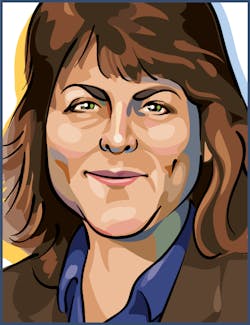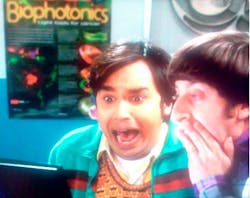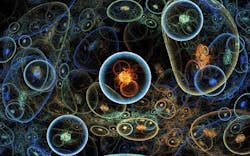
On the heels of just having seen "Jurassic World" in 3D, I was planning to write a blog today on 3D movies, and I will do so soon. But this morning my husband and I were watching a documentary on Stephen Hawking, mostly for our interest in the plight of wheelchair-bound disabled individuals and how they manage to cope. And yet, as a physicist and backyard astronomer, I was keenly interested in the history of Hawking's exploration of the Universe and the various physics theories that have surrounded me for years as a student of the craft.
And so the program on Hawking would not be complete without some discussion of the Big Bang theory. I don't recall exactly what started me thinking about it during the program, but I heard something that tapped into an old familiar feeling/personal opinion that the conventional theory of a single Big Bang was akin to early Earth-centered theories—just too simplistic based on humankind's inclination to only perceive the "here and now" in the tiny sphere that surrounds us. I had alluded to my opinions on this in an earlier blog on the age of the Universe, but life got in the way and I haven't had time to think about it—or just couldn't make the time as there are plenty of other things to keep us distracted.But still, something nags at me regarding the single Big Bang theory. First and foremost, I'm a believer in the multiple big bang theory (see http://www.theguardian.com/science/2006/may/05/spaceexploration.universe for interesting reading, and note that I use the lower case for big bang meaning there have been more than one Big Bang events as we all formally define it). I also subscribe to the multi-Universe or multiverse theory (see http://news.nationalgeographic.com/news/2014/03/140318-multiverse-inflation-big-bang-science-space/). However, while the multiple big bang theory says that multiple big bangs have occurred over time, it still doesn't go far enough. In my thinking and experience, nature and the Universe doesn't just go through major events at different points in time, it also bears witness to phenomenal changes in different physical spaces--and sometimes, all at the same time.
For those reasons, and because my intuition tells me that the Big Bang theory always fell short of a broader view, I officially propose that many or multiple big bangs have occurred over time, but they are also occurring at different locations in space and possibly, even simultaneously. I mean really, if a big bang explosion were happening right now more than 20 billion light-years away (older than one theory of the age of the universe and obviously, farther than we can see in space), would we know it? When would we feel its effects? Perhaps our local universe and local big bang is causing our immediate environment to accelerate outward, but who is to say that ten (or billions) of years down the road the dust storm or haboob outflow (I've been living in Phoenix, AZ too long) of a universes-away big bang wouldn't start to impact our local big bang space and reverse the current outward acceleration that we are experiencing today?
This new theory, which I shall dub the many-spatial-simultaneous big bang theory, seems as reasonable as the vast unknown of the Universe that surrounds us. That indeed, just like the thousands of volcanoes on the surface of the Earth that are erupting at different geological locations, at different times, and even simultaneously, many big bangs could be happening today at vastly different locations in the multiverse, spaced apart by tens of billions of light years in the immensity that is beyond our borders.
But what does any of this have to do with photonics? Quite a bit really; like this proposed theory, light itself and the very photons that comprise it are constantly traveling in time and space, affected by gravity and all the optical obstacles we can throw at them, being stored in some, blocked by others, experiencing spooky action at a distance, entangling with other photons, and basically a part of that energy that can only be distributed and never destroyed. Light is on the move, and who is to say that it is confined to the Universe we can "see" rather than the broader multiverse that we cannot even imagine.One Big Bang debunker talks about evidence that the conventional Big Bang theory is flawed (see http://photontheory.com/bigbang.html). In fact, he even cites work from Hubble and Hoyle that supports the notion that "The Photonics Universe is a non-expanding natural orderly system that has existed forever." Vernon Brown's debunk note also says, "Those who believe that nature is controlled by an all-powerful deity may consider that photons are the thoughts of God. Since this idea can not possibly be proven false, it can not be scientific." Heavy things to think about much less to try, as a scientist, to prove or disprove.
I'm a physics major circa 1986, but I don't profess to know how I would ever go about trying to prove my multiple-spatial-simultaneous big bang theory. I welcome anyone out there from academia with a big bang passion to contact us here at Laser Focus World and let us know your opinion (you can email me at [email protected]). It's possible that because our instruments can only see out so far in space, how freaky and telling would it be that if we were able to look further out, we may see a whole bunch of objects accelerating towards us!! So astronomers, keep pushing the limits of deep-space observation. And for everyone in the photonics community that supports the exploration of deep space and the physics of our human origins, please remember to stretch the envelope, challenge known or assumed truths, and recognize that what you discover today may open up a plethora of discoveries for tomorrow. Per my favorite quote in the world from Albert Einstein, "As our circle of knowledge expands, so does the circumference of darkness surrounding it."
About the Author

Gail Overton
Senior Editor (2004-2020)
Gail has more than 30 years of engineering, marketing, product management, and editorial experience in the photonics and optical communications industry. Before joining the staff at Laser Focus World in 2004, she held many product management and product marketing roles in the fiber-optics industry, most notably at Hughes (El Segundo, CA), GTE Labs (Waltham, MA), Corning (Corning, NY), Photon Kinetics (Beaverton, OR), and Newport Corporation (Irvine, CA). During her marketing career, Gail published articles in WDM Solutions and Sensors magazine and traveled internationally to conduct product and sales training. Gail received her BS degree in physics, with an emphasis in optics, from San Diego State University in San Diego, CA in May 1986.

